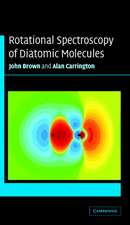Basic Chemometric Techniques in Atomic Spectroscopy: RSC Analytical Spectroscopy Monographs, cartea 10
Editat de Jose Manuel Andrade-Gardaen Limba Engleză Hardback – 14 iun 2009
Preț: 612.77 lei
Preț vechi: 1264.18 lei
-52% Nou
Puncte Express: 919
Preț estimativ în valută:
117.25€ • 122.43$ • 96.82£
117.25€ • 122.43$ • 96.82£
Carte disponibilă
Livrare economică 25 martie-08 aprilie
Preluare comenzi: 021 569.72.76
Specificații
ISBN-13: 9780854041596
ISBN-10: 0854041591
Pagini: 300
Ilustrații: 1
Dimensiuni: 158 x 240 x 21 mm
Greutate: 0.59 kg
Ediția:2009
Editura: Royal Society Of Chemistry
Colecția Royal Society of Chemistry
Seria RSC Analytical Spectroscopy Monographs
Locul publicării:Cambridge, United States
ISBN-10: 0854041591
Pagini: 300
Ilustrații: 1
Dimensiuni: 158 x 240 x 21 mm
Greutate: 0.59 kg
Ediția:2009
Editura: Royal Society Of Chemistry
Colecția Royal Society of Chemistry
Seria RSC Analytical Spectroscopy Monographs
Locul publicării:Cambridge, United States
Public țintă
ResearchDescriere
This is the first book for atomic spectroscopists to present the basic principles of experimental designs, optimization and multivariate regression. Multivariate regression is a valuable statistical method for handling complex problems (such as spectral and chemical interferences) which arise during atomic spectrometry. However, the technique is underused as most spectroscopists do not have time to study the often complex literature on the subject. This practical introduction uses conceptual explanations and worked examples to give readers a clear understanding of the technique. Mathematics is kept to a minimum but, when required, is kept at a basic level.
Cuprins
An overview of atomic spectrometric techniques; Classical linear regression by the least squares method; Implenting a robust methodology: experimental designs and optimisation; Ordinary multiple linear regression and principal components regression; Partial least-squares regression; Multivariate regression using artificial neural networks and support vector mechines; Index
Caracteristici
Practical considerations, interpretations and troubleshooting are emphasized and literature surveys are included to guide the reader to further work
The same dataset is used for all chapters dealing with calibration to demonstrate the differences between the different methodologies
The same dataset is used for all chapters dealing with calibration to demonstrate the differences between the different methodologies
Textul de pe ultima copertă
This is the first book for atomic spectroscopists to present the basic principles of experimental designs, optimization and multivariate regression. Multivariate regression is a valuable statistical method for handling complex problems (such as spectral and chemical interferences) which arise during atomic spectrometry. However, the technique is underused as most spectroscopists do not have time to study the often complex literature on the subject. This practical introduction uses conceptual explanations and worked examples to give readers a clear understanding of the technique. Mathematics is kept to a minimum but, when required, is kept at a basic level. Practical considerations, interpretations and troubleshooting are emphasized and literature surveys are included to guide the reader to further work. The same dataset is used for all chapters dealing with calibration to demonstrate the differences between the different methodologies. Readers will learn how to handle spectral and chemical interferences in atomic spectrometry in a new, more efficient and cost-effective way.
Notă biografică
Jose Andrade-Garda is based in the Department of Analytical Chemistry at the University of A Coru±a where he specializes in quality control and chemometrics. Within the field of chemometrics, his main interests are multivariate regression and pattern recognition methods. In the atomic spectrometry arena, he has applied formal optimization techniques to optimize analytical protocols and used multivariate regression tools to cope with spectral and chemical interferences in ETAAS.


















